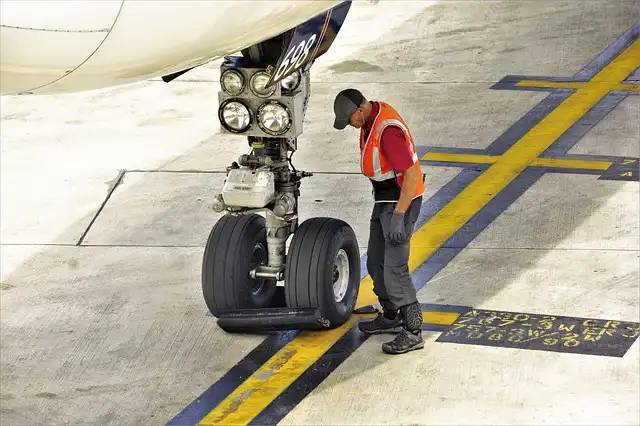Last updated on May 14th, 2025 at 05:19 pm

Ever wondered how vehicles stay securely in place on slopes or during maintenance? That’s where wheel chock come into play. These simple yet essential tools are designed to prevent accidental movement, ensuring safety for you and your surroundings.
A wheel chock is more than just a wedge; it’s a reliable safety measure. Whether you’re parking on an incline or working on heavy machinery, using wheel chocks can give you peace of mind. They’re a small investment with a big impact on safety.
Understanding what wheel chocks are and how they work can save you from potential accidents. Let’s jump into why they’re a must-have for anyone handling vehicles or equipment.
How to use a wheel chock
Position the wheel chock against the vehicle’s tire on the downhill side if parked on an incline. Always chock the tires closest to the slope, placing the chock snugly against the tire to maximize stability.
Select the appropriate size and type of wheel chock based on the vehicle’s weight and tire dimensions. For example, larger trucks may require heavy-duty chocks, while smaller vehicles can use lightweight chocks designed for compact tires.
Before using a wheel chock, engage the parking brake and ensure the surrounding area is secure. When handling heavy equipment, use wheel chocks on all sides to completely immobilize the machinery.
Examine the surface conditions where the chock will be used. Use non-slip chocks or place them on a textured surface when conditions are icy, wet, or muddy to enhance traction.
Store wheel chocks properly after use to maintain their condition. Damaged or worn chocks pose safety risks and should be replaced immediately with functional alternatives.
How many wheel chocks are recommended
The number of wheel chocks depends on the vehicle or equipment type and its specific conditions. For standard vehicles, using two chocks, one for each side of the tire, is a common safety practice. This ensures stability by blocking both directions of potential movement.
Heavier machinery or vehicles parked on steep inclines may require four chocks. You can place one chock on each side of both rear tires to provide maximum security. This setup minimizes the risk of sliding or rolling.
Refer to the manufacturer’s guidelines for precise recommendations. These usually include the minimum number required based on weight and terrain. Always consider additional chocks in situations such as uneven ground or when handling oversized loads.
How tall should a wheel chock be
The height of a wheel chock depends on the tire diameter. A general guideline is that the chock’s height should be at least 25% of the tire’s height. For example, a tire with a diameter of 40 inches would require a wheel chock approximately 10 inches tall. This ensures it provides adequate resistance to prevent movement.
When dealing with heavy equipment or larger vehicles, the chock height may need to be increased. Manufacturers often include specific height recommendations in their product details to account for load capacity and tire size. Always align the height with the weight and type of the vehicle to ensure stable use.
You must also consider terrain and surface conditions. On uneven ground or sloped surfaces, using taller chocks can enhance stability. But, avoid exceeding the proportional height, as this could affect proper placement against the tire. Always verify compatibility before use.
How to stop wheel chock from sliding
Position the chock on a clean, dry surface to improve grip. Dirt, ice, or debris can reduce traction, causing the chock to slide. Sweep the area or use a de-icer if necessary before placing the chock.
Choose wheel chocks made from materials with high friction, such as rubber or polyurethane. These materials offer better resistance to sliding compared to plastic or metal chocks, especially on smooth surfaces.
Use chocks with built-in grip features for added security. Some designs include rubber pads, serrated edges, or grooves that increase surface contact, reducing the chance of movement.
Anchor your chocks on loose surfaces like gravel or sand. Secure the base with stakes or a chock plate to prevent slipping, particularly under heavy loads or adverse conditions.
Check the incline angle when positioning chocks. Steeper slopes increase the risk of sliding, so reinforcement methods like ropes or wheel stops can enhance stability in such situations.
How to select the right wheel chock
Selecting the right wheel chock involves considering multiple factors for effective performance. Start by identifying the vehicle type, as the weight, size, and tire dimensions directly influence the chock’s requirements. For heavy vehicles, choose chocks made from durable materials like aluminum or reinforced rubber to handle substantial loads.
Evaluate the terrain where the chocks will be used. Smooth surfaces may require chocks with non-slip bases, while loose or uneven grounds benefit from chocks featuring cleats or anchor points. Also, weather-resistant materials, such as polyurethane, work best in extreme temperatures or wet conditions.
Check the chock’s height relative to the tire. A height at least 25% of the tire’s diameter is essential. Confirm that the chock’s design aligns with the vehicle’s specific needs, and prioritize options with added grip features if the surface is prone to sliding.